Customer relationship management (CRM) is a process in which a business or other organization administers its interactions with customers, typically using data analysis to study large amounts of information.

A call centre or call center is a managed capability that can be centralised or remote that is used for receiving or transmitting a large volume of enquiries by telephone. An inbound call centre is operated by a company to administer incoming product or service support or information inquiries from consumers. Outbound call centres are usually operated for sales purposes such as telemarketing, for solicitation of charitable or political donations, debt collection, market research, emergency notifications, and urgent/critical needs blood banks. A contact centre is a further extension of call centres telephony based capabilities, administers centralised handling of individual communications, including letters, faxes, live support software, social media, instant message, and email.

Telemarketing is a method of direct marketing in which a salesperson solicits prospective customers to buy products, subscriptions or services, either over the phone or through a subsequent face to face or web conferencing appointment scheduled during the call. Telemarketing can also include recorded sales pitches programmed to be played over the phone via automatic dialing.
Interactive voice response (IVR) is a technology that allows telephone users to interact with a computer-operated telephone system through the use of voice and DTMF tones input with a keypad. In telephony, IVR allows customers to interact with a company's host system via a telephone keypad or by speech recognition, after which services can be inquired about through the IVR dialogue. IVR systems can respond with pre-recorded or dynamically generated audio to further direct users on how to proceed. IVR systems deployed in the network are sized to handle large call volumes and also used for outbound calling as IVR systems are more intelligent than many predictive dialer systems.

Automation describes a wide range of technologies that reduce human intervention in processes, mainly by predetermining decision criteria, subprocess relationships, and related actions, as well as embodying those predeterminations in machines. Automation has been achieved by various means including mechanical, hydraulic, pneumatic, electrical, electronic devices, and computers, usually in combination. Complicated systems, such as modern factories, airplanes, and ships typically use combinations of all of these techniques. The benefit of automation includes labor savings, reducing waste, savings in electricity costs, savings in material costs, and improvements to quality, accuracy, and precision.
The Toyota Production System (TPS) is an integrated socio-technical system, developed by Toyota, that comprises its management philosophy and practices. The TPS is a management system that organizes manufacturing and logistics for the automobile manufacturer, including interaction with suppliers and customers. The system is a major precursor of the more generic "lean manufacturing". Taiichi Ohno and Eiji Toyoda, Japanese industrial engineers, developed the system between 1948 and 1975.
Telephone slamming is an illegal telecommunications practice, in which a subscriber's telephone service is changed without their consent. Slamming became a more visible issue after the deregulation of the telecommunications industry in the mid-1980s, especially after several price wars between the major telecommunications companies. The term slamming was coined by Mick Ahearn, who was a consumer marketing manager at AT&T in September 1987. The inspiration for the term came from the ease at which a competitor could switch a customer's service away from AT&T by falsely notifying a telephone company that an AT&T customer had elected to switch to their service. This process gave AT&T's competitors a "slam dunk" method for the unauthorized switching of a customer's long-distance service. The term slamming became an industry standard term for this practice.

Customer service is the assistance and advice provided by a company through phone, online chat, and e-mail to those who buy or use its products or services. Each industry requires different levels of customer service, but towards the end, the idea of a well-performed service is that of increasing revenues. The perception of success of the customer service interactions is dependent on employees "who can adjust themselves to the personality of the customer". Customer service is often practiced in a way that reflects the strategies and values of a firm. Good quality customer service is usually measured through customer retention.
In marketing, lead generation is the process of creating consumer interest or inquiry into the products or services of a business. A lead is the contact information and, in some cases, demographic information of a customer who is interested in a specific product or service.
Poka-yoke is a Japanese term that means "mistake-proofing" or "error prevention". It is also sometimes referred to as a forcing function or a behavior-shaping constraint.

Call centers began in the Philippines as providers of email response and managing services then broadened to industrial capabilities for almost all types of customer relations, ranging from travel services, technical support, education, customer care, financial services, online business-to-customer support, and online business-to-business support. The call center industry is one of the fastest growing in the country.
Chargeback fraud, also known as friendly fraud, cyber shoplifting, or liar-buyer fraud, occurs when a consumer makes an online shopping purchase with their own credit card, and then requests a chargeback from the issuing bank after receiving the purchased goods or services. Once approved, the chargeback cancels the financial transaction, and the consumer receives a refund of the money they spent. Dependent on the payment method used, the merchant can be accountable when a chargeback occurs.
A soundboard is a computer program, Web application, or device, formerly created in Adobe Flash, that catalogues and plays many audio clips. Soundboards are self-contained, requiring no outside media player. In recent years soundboards have been made available in the form of mobile apps available on iPhone App Store and Google Play. Since Adobe and web browser developers deprecated support for Flash, HTML5-based soundboards have gained popularity in recent years.
The backbone of office automation is a local area network, which allows users to transfer data, mail and voice across the network. All office functions, including dictation, typing, filing, copying, fax, telex, microfilm and records management, telephone and telephone switchboard operations, fall into this category. Office automation was a popular term in the 1970s and 1980s as the desktop computer exploded onto the scene. Advantages of office automation include that it can get many tasks accomplished faster, it eliminates the need for a large staff, less storage is required to store data, and multiple people can update data simultaneously in the event of changes in schedule.

Credit card fraud is an inclusive term for fraud committed using a payment card, such as a credit card or debit card. The purpose may be to obtain goods or services or to make payment to another account, which is controlled by a criminal. The Payment Card Industry Data Security Standard is the data security standard created to help financial institutions process card payments securely and reduce card fraud.
A virtual help desk allows IT support organizations to virtually deploy IT technicians on demand to support a computer user experiencing technical issues. IT can efficiently manage and allocate global help desk resources, including – most importantly – its personnel, to access any computer to provide support despite the end user or IT rep location. Virtual help desks allow IT reps to virtually access end systems through support sessions where they can diagnose and fix computer issues quickly. This eliminates in-person customer service calls and/or ineffective phone-only tech support sessions, making the help desk more efficient. Another objective of the virtual help desk is to improve IT resource management and save organization's money by increasing IT support efficiencies. Through an enhanced ability to allocate resources, IT organizations have the flexibility to create new ways of using its technical support knowledgebase. This technology usually requires a software implementation and support contract.
Voice-based marketing automation (VBMA) refers to software platforms designed for marketing, sales, and support departments to measure, manage, and automate their phone conversations. Marketing departments, sales teams, and support agents use VBMA to initiate, manage, monitor, track, route, record, and report on sales and support phone conversations.
In marketing, contact center telephony is the communication and collaboration system used by businesses to either manage high volumes of inbound queries or outbound telephone calls keeping their workforce or agents productive and in control to serve or acquire customers. This business communication system is an extension of computer telephony integration (CTI).
Unified communications (UC) management is essentially the management of unified communications; it refers to the systems used by enterprise organizations to automate their enterprise communications services and the voice network infrastructure that those services run over.

Hancock is a C-based programming language, first developed by researchers at AT&T Labs in 1998, to analyze data streams. The language was intended by its creators to improve the efficiency and scale of data mining. Hancock works by creating profiles of individuals, utilizing data to provide behavioral and social network information.






